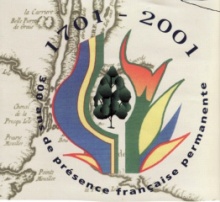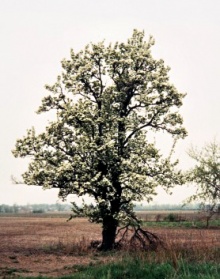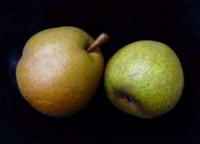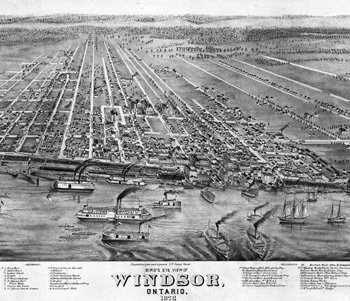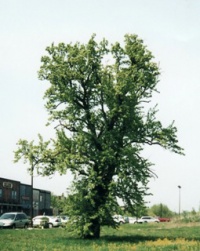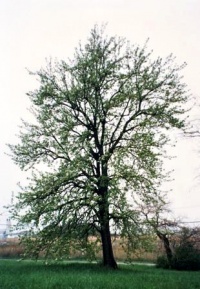Jesuit Pear Trees
par Bénéteau, Marcel
In 2001, the Canadian committee integrated the Jesuit pear tree into its logo for the 300th anniversary celebrations commemorating the founding of the city of Detroit by Antoine Lamothe-Cadillac. According to tradition, this majestic tree was introduced into the region by the Jesuits at the beginning of the 18th century. Although once typical of the region, the giant pear trees, whose origins go back to the New France period, have become rare and their future is uncertain. Since 2001, they have come to be recognised as the living symbol of the Detroit Region's French-speaking community, which is now concentrated on the Canadian side of the border around the city of Windsor. By creating a symbolic link between their fate and that of the Jesuit pear tree, the Detroit Francophone community has made a commitment to protecting their own heritage, as well as their historical, and cultural value, all the while reaffirming their characteristic vitality.
Article disponible en français : Poiriers des Jésuites
The Jesuit Pear Trees and the Detroit Region
The trees known as the "Jesuit pear trees" can be considered as reliable indicators of the presence of a French-speaking community in the Detroit region and are evidence of the impressive length of time this community has been established on both the American and Canadian sides of the international border that now runs down the middle of the Detroit River.(NOTE 1) A few dozen specimens of the tree can be found on each side of the border, from the mouth of Lake Erie to the shores of Lake St. Clair. The trees that remain in the city of Windsor are mostly concentrated along the Detroit River and the streets marking the second and third land concessions granted to the first settlers in the 18th and 19th centuries. Most of the villages established by French settlers in the Canadian counties, including in Essex County, as well as along the shores of Lake St. Clair, still have a few venerable surviving examples of the tree still flourishing in the area. On the American side of the river, where industrial and economic development has wiped out practically every trace of the city's French origins, there are still several fine specimens of the tree, which are mostly located in Grosse Pointe, north of Detroit, and in Monroe, to the south.
The Jesuit Pear Trees Today
Although the pear trees of today do not seem to reach the enormous sizes mentioned in the historical accounts, they can nevertheless attain impressive dimensions. One venerable specimen, located near Harrow, Ontario, estimated to be over 200 years old, is 12 metres (40 ft) high with a trunk measuring 5.7 metres (18.7 ft) in circumference. Others found in Windsor and in the village of Rivière-aux-Canards have nearly reached such colossal dimensions. Despite their great age and their sometimes very advanced state of decay, most of these trees still produce, year in and year out, a large number of tiny, sweet, slightly spicy pears. Their rather more round than pear-shaped fruit ripens in mid-August.
In today's orchards, the commercial value of these pear trees is not at all in proportion to their size, for the giant specimens are completely out of place among fruit trees that are rarely more than two metres (6.5 ft) high. In fact, the enormous size of the pear trees makes gathering their fruit very difficult indeed. Moreover, this traditional fruit bears little resemblance to the ideal pear sought by the contemporary consumer, who insists on a large, uniformly-shaped product. Although they are delicious straight from the tree, in the past these pears were more often than not preserved or canned, two practices that have now become obsolete (see Appendix). The fact that these trees are considered to be of little economic value and because their historical and cultural importance is generally unknown, they have not been considered prime candidates for preservation. Residential development on former farmlands along the Detroit River has also decimated the Jesuit pear tree population. In addition to these problems, when one takes into consideration the fact that the trees are difficult to plant and their long maturation period (it takes approximately 20 years before they become productive), it is easy understand why they have sadly now become so rare. Therefore, only a few dozen authentic specimens can be found on the Canadian side of the river today.
There is however a growing interest outside the French-speaking community in the fate of the Jesuit pear trees, for many consider them to have substantial historic value. Indeed, in spite of their small size, which detracts from their commercial viability, the pears have attracted the attention of researchers from Agriculture Canada who have initiated a project intended to determine the genotype of the species in order to preserve some of its useful characteristics for posterity, particularly its natural resistance to insects and fire blight, its robustness, and its extreme longevity. However, given that precise information concerning the origin and culture of the species is scattered and rare, these researchers have had to turn to historians and ethnologists for help.
The Historical and Popular Origins of the Jesuit Pears
Nineteenth- and twentieth-century sources agree that the Jesuit pears were once among the most striking features of the Detroit region landscape. In her 1887 memoirs, the American writer Bela Hubbard observed that a certain number of pear trees grew on each French farm along the Detroit River.(NOTE 2) Other sources maintained that the trees were always planted in groups of 12, to represent the 12 apostles. We find descriptions of extraordinary specimens towering over 20 metres (65 ft) high, which were said to produce 40 to 60 bushels of pears per year. A number of authors pointed out that the pear trees looked more like oaks or elms than fruit trees. In his classic 1921 study entitled The Pears of New York, Ulysses P. Hedrick observed that "The history of the pear in America cannot be written without making note of the magnificent specimens of this fruit standing until recent years - a few may still be found - about the old French settlements in Michigan..." (NOTE 3) He emphasised the fact that the French were the first to cultivate fruit trees in North America and also remarked that pear trees similar to the Detroit trees could be found in the settlements of Illinois, Indiana and Missouri that were originally French-speaking.
The inhabitants of the Detroit region became renowned very early on for their orchards and for their production of cider. Hubbard describes the old cider mills that were still in existence there at the beginning of the 19th century and named several varieties of apples developed in the 18th century by the early French settlers. (NOTE 4) In fact, the city's soil and climate were and still are quite well suited to fruit cultivation, including peaches and quinces, which are rarely grown elsewhere in Canada. In his very first report to his superiors in 1701, Detroit city founder, Lamothe-Cadillac, vaunted the excellent qualities of the new settlement and praised the "long, wide rows of young and old fruit trees [that], weighed down by the sheer quantity of their fruit, give way and curve their branches toward the very fertile soil out of which they sprung." He also observed that: "the ground is covered with apples and plums" but never alluded to pears in this visual description of his earthly paradise.(NOTE 5) In fact, it is difficult to find evidence of the pear trees in 18th century writings. Despite the name that the trees acquired, their supposed original propagators, the Jesuits, left no apparent evidence of their handiwork: the trees are not mentioned in the Jesuit Relations or in the voluminous writings of Pierre Philippe Potier, a missionary who lived among the Hurons and French settlers of Detroit from 1744 to 1787. The importance of apples and apple cider to the local economy is revealed in a significant number of 18th century account books that have been preserved at the Burton Historical Collection in Detroit, but once again no mention is made of the Jesuit pear trees.
American Authors and the Mission Pear Trees
The earliest attested mention of these already venerable pear trees was written during the second half of the 19th century, when certain American authors make use terms Jesuit or Mission pear trees in writings that also pass on numerous traditional accounts concerning their origins. The most widespread version gives direct credit to the Jesuit missionaries for having introduced the fruit trees into the region. According to this account, the missionary priests apparently planted them during their travels, using pips, chips or cuttings brought from France or from the St. Lawrence Valley (the sources differ concerning the means of propagation). The scientific consensus today is that they were first planted using pips. In a poem entitled "The Mission Pears," written by J. L. Bates around 1850, it would seem that a young lover planted the first pear tree on the edge of the Detroit River to remind him of his fiancée who had remained behind in France. Nevertheless it was an old Jesuit who had suggested that he do so in order that, from that time on, the wilderness would "blossom into fruit." (NOTE 6) In another story, the original propagator was a French immigrant who came to the New World with three pips hidden in his jacket pocket. All of these tales have one thing in common: the pear tree serves to maintain a link with the homeland. For instance, when François Navarre left Detroit in 1787 to establish a new settlement in Rivière-aux-Raisins (now Monroe, Michigan), he made sure to fill his saddlebag with a number of small pear trees that he would plant on his new plots of land and distribute to the inhabitants of the new settlement. No surviving historical documents confirm the veracity of these folktales, but the fact remains that the link with the Jesuits is mentioned time and again. However, it should be noted that, in the Penetanguishene region of Ontario, not far from the former Sainte-Marie des Hurons mission-where the climate is much too harsh for cultivating pears-the local French speakers also make use of the term Jesuit apple trees.
Another belief that has already been mentioned concerns the custom that requires Jesuit pear trees be planted in groups of 12, one for each apostle. The twelfth tree, representing Judas, was supposed to be planted apart from the others. First appearing in the accounts of 19th century writers, this practice was later declared to be an established fact in a number of 20th century sources. A series of articles published in the Detroit Free Press in 1941 chronicles the events surrounding the imminent death of the last "apostle" of just such an orchard. An elaborate ceremony was planned to mark the planting of cuttings that would insure the grove's ongoing existence. However, as the articles included in the Appendix reveal-much to the great consternation of the celebrants-the venerable patriarch turned out to be the tree representing Judas, not St. Peter, whom the assembled celebrants wished to honour. (NOTE 7) This same orchard is depicted in "The Widow's Curse," a folktale published in 1883 by Marie Caroline Watson Hamlin. (NOTE 8) The tale explains the origin of the Judas tree custom (see Appendix). The story makes for pleasant reading, but it should be noted that most of today's surviving pear trees are isolated specimens that do not seem to have been part of orchards where trees were planted in groups of 12.
Renewed Interest in the Fruit Tree
Nineteenth-century authors deplored the seemingly inevitable disappearance of the pear trees and with it the demise of the old French culture that would inevitably be swept aside by the inexorable march of progress initiated by the rise of the new American republic. This no doubt explains their propensity for creating folktales that attribute a highly symbolic and heritage value to these threatened trees. However, both the Jesuit pear trees and the French speaking community have survived to this day. The Detroit region French speakers have made these trees, whose existence is both long lasting and precariously fragile, both threatened and vibrantly alive, the living symbol of French settlement in one of the most remote and isolated corners of French North America. In 2001, during the 300th anniversary celebrations of the founding of Detroit, the city of Windsor officially recognized the power of this symbol by planting three pear trees on the Canadian side of the Detroit River to commemorate the 1749 arrival of the first settlers on the south bank of the river. It was these very same settlers who established the area's first French speaking community on the Canadian side of the border. The pear trees also served as the logo for a major exhibit on the history of French speakers of Southwestern Ontario, which was held at the Maison François-Baby, home to Windsor's Community Museum (see Appendix). In another exhibit, the museum encouraged visitors to indicate (by marking a map) any pear trees they knew to exist in Essex County. This initiative enabled the museum to locate and confirm a dozen heretofore-unidentified specimens.
Other projects have been created in order to showcase and promote the Jesuit pear tree. During the 300th anniversary celebrations of the founding of Detroit, a group of area French speakers founded a tree nursery, in order to provide pears anyone interested in propagating the species. During a 2006 convention on religious heritage held in Pointe-de-l'Église, Nova Scotia, members of the same group of French speakers presented a Jesuit pear tree to their hosts and the tree was subsequently planted on the campus of Université Sainte-Anne. Agriculture Canada, which is currently looking to incorporate as many samples [of varieties of species] as possible into its gene bank, has also initiated an awareness campaign, in order to help the general public identify and conserve this living symbol of the Detroit region's French-speaking community.
Marcel Bénéteau
Département
de Folklore et Ethnologie de l'Amérique Française
University of Sudbury, Ontario
NOTES
Note 1: The former French colony of Detroit, established on both sides of the Detroit River, was separated by an international border once the Americans established themselves permanently in the region in 1796. A major French-speaking community was in existence the American side until the early decades of the 20th century. Even today, a number of families of French origin have members on both sides of the border.
Note 2: Bella Hubbard, Memorials of a Half-Century, New York and London, G.P. Putnam's Sons, 1887, p. 126.
Note 3: U.P. Hedrick, The Pears of New York. Report of the New York Agricultural Experiment Station for the Year 1921, Albany, J. B. Lyon, 1921, pp. 47-48.
Note 4: Hubbard, op. cit.
Note 5: Pierre Margry, Découvertes et établissements des Français dans l'ouest et dans le sud de l'Amérique septentrionnale, 1614-1754, Paris: Imprimerie D. Jouaust, 1876-1886, V:192.
Note 6: J. L. Bates, "The Mission Pears," quoted in Silas Farmer, History of Detroit and Wayne County and Early Michigan, Detroit, Silas Farmer and Co., 1886.
Note 7: Detroit Free Press, April 27, 1941 and May 2, 1941.
Note 8: Marie Caroline Watson Hamlin, Legends of le Détroit, Detroit, Thorndike Nourse, 1884.
BIBLIOGRAPHY
Farmer, Silas, History of Detroit and Wayne County and Early Michigan, Détroit, Silas Farmer and Co., 1886.
Hedrick, U.P., The Pears of New York. Report of the New York Agricultural Experiment Station for the Year 1921, Albany, J. B. Lyon Company, Printers, 1921.
Hubbard, Bella, Memorials of a Half-Century, New York et London, G.P. Putnam's Sons, 1887.Lajeunesse, Ernest J., The Windsor Border Region. Canada's Soutnernmost Frontier, Toronto, University of Toronto Press.
Margry, Pierre, Découvertes et établissements des Français dans l'ouest et dans le sud de l'Amérique septentrionnale, 1614-1754, Paris, Imprimerie D. Jouaust, 1876-1886.
Reaman, Elmore G., A History of Agriculture in Ontario, Volume One, Toronto, Saunders of Toronto Ltd., 1970.
Watson Hamlin, Marie Caroline, Legends of le Détroit, Detroit, Thorndike Nourse, 1884; traduction française, Richard Ramsay, Le Détroit des légendes, Sudbury, Société Historique du Nouvel-Ontario, 1991.
Woodford, Arthur M. (éd.), Tonnancour : Life in Grosse Point and along the Shores of Lake Saint Clair, vol. 1, 1994.
Additional DocumentsSome documents require an additional plugin to be consulted
Documents PDF
-
 « The Old Pear Trees of Detroit », poème de W.H. Coyle
« The Old Pear Trees of Detroit », poème de W.H. Coyle
-
 Article du Detroit News, 2 mai 1941
Article du Detroit News, 2 mai 1941
-
 Article du Detroit News, 27 avril 1941
Article du Detroit News, 27 avril 1941
-
 Recette des poires marinées
Recette des poires marinées
-
 Texte de la légende « La malédiction de la veuve »
Texte de la légende « La malédiction de la veuve »

